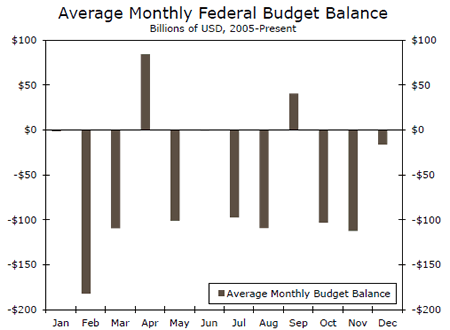U.S. Review
Slight Firming in Inflation Ahead of FOMC Meeting
- After three months of lower-than-expected inflation readings, the CPI came in higher than expectations. Despite inflation’s relatively tepid trend, FOMC members have continued to signal that they are set to announce the start of balance sheet normalization at next week’s meeting.
- Hurricane damage is beginning to show up in the monthly data. August retail sales contracted from the previous month, with notable weakness in auto sales.
- Industrial production surprised to the downside with manufacturing production contracting 0.3 percent in August.
Economic Data under Close Watch by the Fed
Consumer prices rose 0.4 percent in August, the largest monthly jump since January. Leading the index was a 2.8 percent rise in energy costs. Prices for gasoline had already been inching higher ahead of the Harvey-related surge late in the month. To what will likely be a relief to Fed officials, core inflation rose 0.2 percent in August, which was the largest monthly gain since February. On a year-over-year basis, core inflation continues to undershoot the Fed’s 2 percent inflation target. Ex-food and energy, prices were up just 1.7 percent over the past 12 months. Following the firming in August, however, the recent trend looks stronger; over the past three months, the core index has risen at a 1.9 percent annualized pace.
August’s gain should help alleviate concerns among Fed members that the slowdown in inflation that began in the spring might prove more lasting. FOMC members have continued to telegraph that they are set to announce the start of balance sheet normalization at next week’s meeting. We do not expect the inflation data to get in the way of that plan. What is likely to be affected, however, is the Fed’s Summary of Economic Projections. There will be three more readings on CPI and PCE inflation before the FOMC’s December meeting, but the soft patch hit in prior months is likely to lead to lower estimates of year-end core inflation, which may push out the members’ projections for the timing of the next rate hike.
Retail Sales and Industrial Production Disappoint
While August’s CPI print may have lessened concerns about the recent slowdown in inflation among Fed members, notable weakness in the retail sales and industrial production reports may make the members reassess the general strength of the economy. The pronounced weakness in these two reports may be related to Hurricane Harvey.
Headline retail sales dropped 0.2 percent, with auto sales trimming 0.3 percentage points from topline growth. The decline in auto sales more than offset the boost from the 2.5 percent rise at gas stations. The surge in gasoline sales was largely expected, due to stocking up in storm affected areas. Moreover, the 0.5 percent decline in building material sales on the month, suggests most of that spending took place in September – this category will likely see a boost in September as Houston and the state of Florida rebuild and recover from the storm.
Industrial production data was also off sharply in August, declining 0.9 percent. Manufacturing production, which includes petroleum refining and petrochemical production in and around Houston, declined 0.3 percent in August, following a flat reading in July. Utilities posted the steepest drop, contracting 5.5 percent. Mild temperatures across the U.S. led to lower usage of air conditioning. The weaker than expected data appears to be largely accounted for Harvey-related effects which are likely transitory in nature. The Empire State Manufacturing index for September, a regional purchasing managers’ index, suggests that beyond the recent weather-related industrial disruptions, factory activity remains strong.
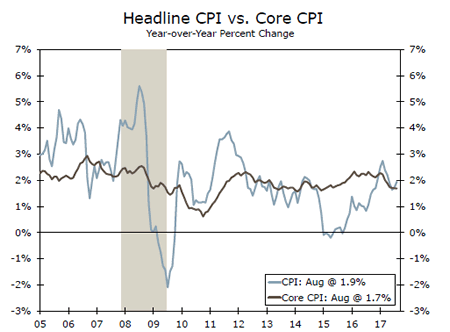
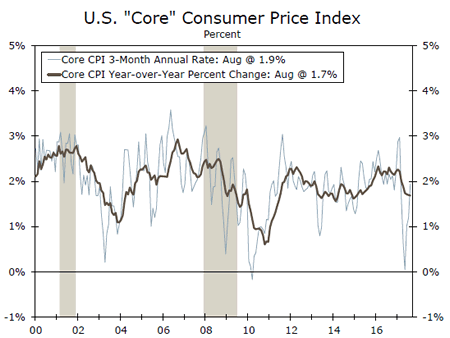
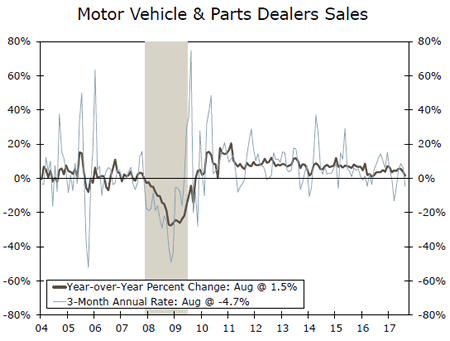
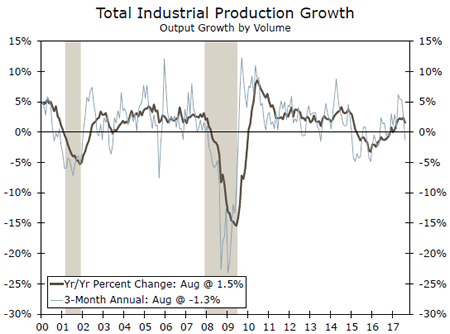
U.S. Outlook
Housing Starts • Tuesday
Housing starts had a disappointing month of July, falling 4.8 percent on the month and down 5.6 on a year-ago basis. The weakness in July was concentrated in the multifamily component of the index, which fell 15.3 percent. Given the late-cycle fundamentals in that market, the drop is not surprising. Shortages in both lots and labor are holding back starts. Houston has been a key driver of housing construction this year, and Hurricane Harvey will almost certainly cause delays in planned housing starts.
Looking ahead, we expect August starts at a 1.174 million unit pace, an increase of 1.6 percent. We estimate that starts will be around 1.220 million units for 2017, down slightly from our prior forecast due to implications from both Hurricane Harvey and Irma, as single-family building will be held back in parts of Texas and Florida due to delays tied to those storms.
Previous: 1,155K Wells Fargo: 1,174K Consensus: 1,175K
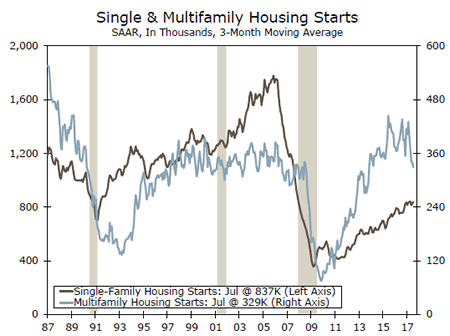
Import Prices • Tuesday
In July, import prices rose a paltry 0.1 percent due to a 0.7 percent increase in imported petroleum prices, matching expectations. Import prices ex-fuel declined last month, however, the first drop since January. Last month, autos & parts prices fell, while capital goods and food & beverages prices increased. The greenback is down around 7 percent year-to-date, and is expected to take on further declines. This should boost prices on imported goods through the end of the year.
Next week, we expect to see import prices gain 0.5 percent monthto- month due to the dollar slide. However, we also expect the effect of elevated import prices will be limited on consumers, as prices on goods and services that are domestically produced should not be pushed upward by global exchange rates.
Previous: 0.1% Wells Fargo: 0.5% Consensus: 0.4% (Month-over-Month)

Existing Home Sales • Wednesday
The low inventory of existing homes for sale capped sales in July, with sales slipping to a 5.44 million unit pace, compared to a 5.51 million unit pace in June. Demand for housing remains strong thanks to low mortgage rates, job growth and rising income. Competition among buyers is stiff. Supply remains low and prices are rising as a result. First-time homebuyers are being priced out of the market with the high prices of homes, and home sales at the lower-end of the price spectrum have declined in every region of the nation over the year.
We expect existing home sales in the month of August to slightly fall to a 5.43 million unit pace. Texas and Florida account for 18.8 percent of existing home sales year-to-date, so we could see a stall in existing home sales in these markets throughout the end of the year, but this will likely be seen more in September compared to August.
Previous: 5.44M Wells Fargo: 5.43M Consensus: 5.46M
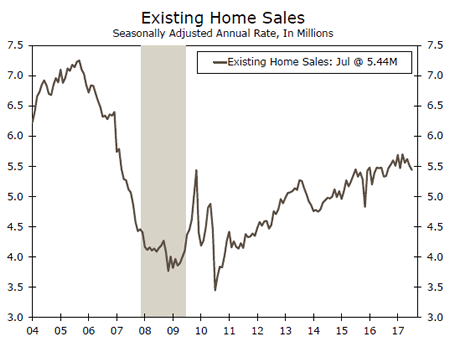
Global Review
Chinese Economy Cools at Summer’s End
- Economic data out of China disappointed across the board this week. Retail sales and industrial production growth both came in below consensus.
- In the United Kingdom, the Bank of England’s Monetary Policy Committee voted 7-2 in favor of keeping its policy rate and balance sheet unchanged. The pound and U.K. government bond yields jumped on hawkish language.
- The Brazilian economy continued its long climb back from a severe recession. The economic activity index for July topped expectations, rising 0.4 percent over the month in addition to a small upward revision to the previous month.
Chinese Economy Cools at Summer’s End
Economic data out of China disappointed across the board this week. Retail sales growth on a year-over-year basis was 10.1 percent in August, 0.4 percentage points below the consensus. Industrial production growth also missed the mark, slowing to 6.0 percent year-over-year despite expectations for a 6.6 percent gain. Both readings were the slowest pace so far in 2017.
Leverage in the non-financial corporate (NFC) sector in China has become a growing concern. Chinese authorities are well aware of the leverage that has been built up in the NFC sector in recent years, and they are trying to rebalance the economy away from its over-reliance on investment spending toward more consumer spending before a debt crisis causes the economy to implode. As a result, authorities have eased up on the policy pedal in recent months, and it appears the economy has begun to feel the effects.
High debt levels and less free flowing credit, coupled with longerterm challenges such as an aging population, support our view for a continued but gradual deceleration in the Chinese economy next year. For more on NFC leverage in China, see our report released Thursday "Should We Worry about Chinese SOEs?"
In the United Kingdom, the Bank of England’s (BoE) Monetary Policy Committee (MPC) voted 7-2 in favor of keeping its main policy rate and balance sheet unchanged. The language in the policy statement noted that "monetary policy could need to be tightened by a somewhat greater extent over the forecast period than current market expectations." This hawkish tact led the pound and U.K. government bond yields to jump.
Above-target inflation is the key to the Bank of England’s bias towards tightening policy next year. The sharp depreciation of the currency in the wake of Brexit last year has driven consumer price inflation to nearly 3 percent, almost a full point above the central bank’s target (middle chart). An above-consensus print for the August consumer price index released this past Tuesday only reinforced that point. Sluggish wage growth has kept the MPC in check; despite the acceleration in prices and an unemployment rate at a 42-year low, wages have decelerated in 2017 relative to H2-2016. We look for the Bank of England to next hike rates in Q2-2018.
Across the channel, industrial production growth continued to firm in the Eurozone, rising 3.2 percent year-over-year in July from an upwardly revised 2.8 percent in June. Industrial production has accelerated, helping corroborate the marked improvement in sentiment demonstrated by manufacturing purchasing manager indices.
Elsewhere, the Brazilian economy continued its long climb back from a severe recession. The economic activity index for July topped expectations, rising 0.4 percent over the month in addition to a small upward revision to the previous month. Although the Brazilian political corruption crisis has continued on, it appears that a more firm environment for commodities and global economic growth more generally have helped the Brazilian economy turn the corner after several years of contraction.
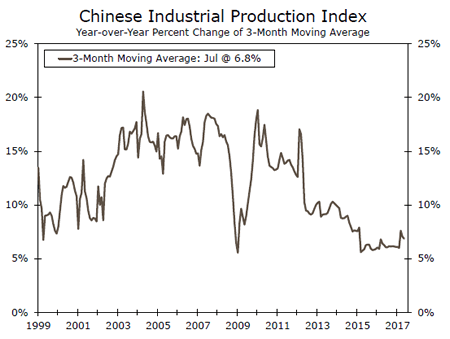
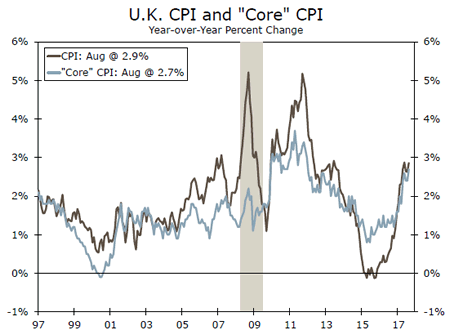
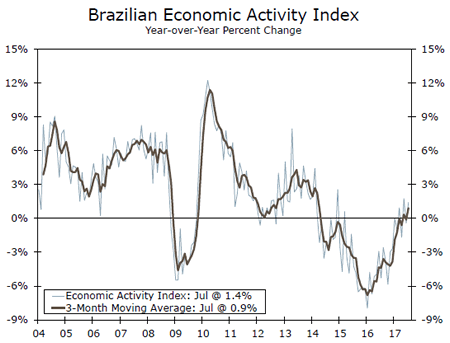
Global Outlook
United Kingdom Retail Sales • Wednesday
The U.K. is scheduled to release August retail sales data this upcoming Wednesday. Real retail sales have been decelerating recently as rising inflation and stagnant wage growth have taken a bite out of household purchasing power. The consensus estimate expects that retail sales grew 0.1 percent in August, month over month, and 1.2 percent on a year-ago basis. Both these estimates represent a slowdown from July in which retail sales grew 0.3 percent month over month and 1.5 percent year over year. On a year-over-year basis, real retail spending was up only 2.6 percent in Q2, which clearly represents a slowdown relative to the breakneck pace of the past few years.
Looking ahead, we forecast that real GDP growth will strengthen modestly in 2018 as some of the forces that have led to a slowdown this year reverse, although uncertainty related to Brexit continues to lurk in the background as a major downside risk to the economy. Previous: 0.3%
Consensus: 0.1% (Month-over-Month)
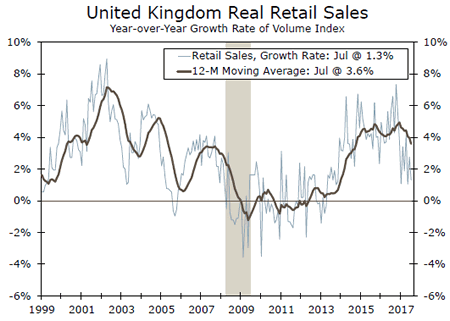
Canada CPI • Friday
Canadian consumer price inflation data are scheduled to be released next Friday. Last week, the Bank of Canada (BoC) raised rates in a move that was somewhat anticipated by markets, but generally not expected by most economists. Economic data coming out of our northern neighbor have been stronger than expected, leading the BoC to judge that the faster rate of growth to be "more broadly based and self-sustaining." The September rate hike likely takes another hike in October off the table.
The headline rate of CPI inflation in Canada is just 1.2 percent at present, near the low end of the target range. We expect CPI to have grown 0.1 percent month over month in August and 1.4 percent year over year. Also on the docket for next week is Canadian retail sales data for July. Retail sales were up 7.3 percent on a year-ago basis in June.
Previous: 1.2% Wells Fargo: 1.4% Consensus: 1.5% (Year-over-Year)
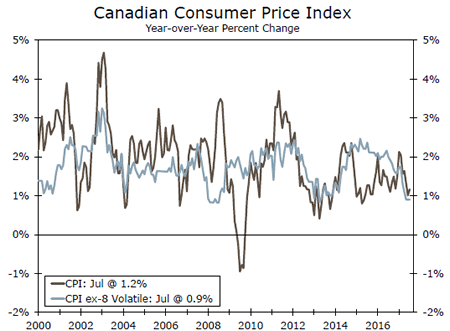
Eurozone PMIs • Friday
Preliminary Eurozone manufacturing and service PMI data for September will be released next Friday. The PMI for manufacturing in August was well in expansion territory at 57.4, tying the series’ high. The service sector PMI dropped to 54.7 in August from 55.4 in July, and has slowly come off its April series’ high, but remains firmly in expansionary territory. Real GDP in the Eurozone accelerated in Q2, as economic growth has become increasingly broad based in recent quarters amid steady employment gains and improving business sentiment. This marks the 17th consecutive quarter in which real GDP has risen on a sequential basis.
Looking forward, we expect that the increasingly self-sustaining economic expansion will remain intact. Our current forecast looks for real GDP in the Eurozone to grow 2.1 percent in 2017 and 2.0 percent in 2018.
Previous: Manufacturing: 57.4; Services: 54.7 Consensus: Manufacturing: 57.2; Services: 54.8

Point of View
Interest Rate Watch
Student Loan Breakout
Details of the student credit experience provide a number of insights into the strength of consumer spending and the outlook going forward.
Origination By Credit Quality
As the economic expansion has matured, the share of deep-subprime and subprime loans originated has declined compared to 2010-2012 (top graph). This is expected since individual credit quality improves as job growth strengthens and many individuals reduce their outstanding debt. Over the same past four years, the share of prime and super-prime loans has risen.
Another Signal of Improvement
Over the past four years for which data is available, cohort default rates have declined after a peak in FY2010 (middle graph). This improvement has coincided with a rise in the average award since the 2008-2009 recession.
Default Rates by Borrowing Amounts
What remains a surprise to many casual observers is that the details signal that the five-year default rates by borrowing amount actually decline with the size of the borrowing amount (bottom graph).
The smaller borrowing amounts may reflect drop-outs. These are students that took one or two semesters, borrowed the money but never completed their degree. They have the liability (the student loan) but not the asset (diploma).
Not shown, but also critical, is that five-year default rates decline by the average income of the borrower’s zip code. This again signals that a higher income may be associated with a better ability to pay off the debt even during what may be perceived as a weak job market.
Interest Rates on Student Loans
Interest rates on new student loans track the 10-year Treasury note rates set at the May auction, and then remain fixed for the life of the loan. For students starting college this academic year, interest rates are 0.69 percentage points higher than a year ago, due to a spike in the 10-year yield. Along with future increases as the Fed normalizes policy, this could negatively impact default rates going forward.


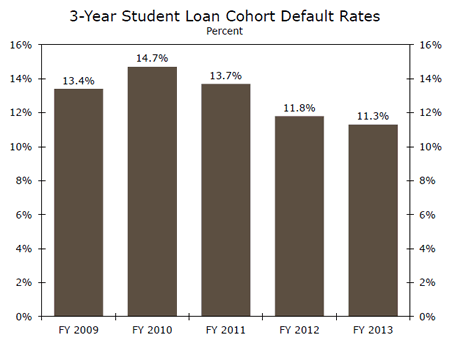
Credit Market Insights
Safety Hammers Convenience
As roughly 143 million Americans were affected by the expansive data breach disclosed last week, consumer fears may weigh on the convenience of accessing credit. In an attempt to combat the lost sense of security, there has been a surge in freezing credit. As freezes were traditionally utilized by individuals who have experienced identity theft, or repetitive fraudulent activity, this recent rise could have implications on the financial industry.
A credit freeze prevents a lender from freely accessing a potential borrower’s credit, affixing a password authentication as a road block prior to accessibility. Although this extra step of safety appears enticing, it lessens the convenient nature of openness to a consumer’s creditworthiness. This lack of accessibility has implications on the lender, increasing the timeframe between a request for credit, and the actual installment. The rise may limit credit volume and could cause a decline in the quantity of loans.
The Federal Reserve Bank of Philadelphia published a report in 2014 on credit fraud, linking the 2012 data breach at the South Carolina Department of Revenue with a rise in credit freezes. But with scarce government data on credit freezes, it remains difficult to truly assess any future implications of such a rise. Although a rise in the freezing of credit appears to be an effect of the recent data breach, we must remain cautious of any implications on the future of the credit markets.
Topic of the Week
Legislative Hurricane Blows Through DC
Last week Congress unexpectedly passed a combined funding bill, debt limit suspension and Hurricane Harvey aid package. The package uses a continuing resolution to fund the government and suspends the debt limit through December 8. The bill also allocates $15.3 billion toward Hurricane Harvey relief, $7.4 billion towards FEMA’s Disaster Relief Fund and extends the National Flood Insurance Program through December 8.
Importantly, the provision suspending the debt ceiling does not set December 8 as a "hard" deadline. After exhausting all of its extraordinary measures over the past six months, lifting the debt ceiling will allow the Treasury to refresh these maneuvers in the coming months. We are skeptical that the extraordinary measures will be able to last far beyond the December 8 reestablishment of the debt ceiling due to the timing of tax filing season. February and March usually see large outflows due to individuals who file their taxes early in anticipation of a tax refund, resulting in large monthly deficits. That said, the take away is that there will be some time between when the government’s authority to borrow ends on December 8 and when the Treasury actually runs out of the ability to issue new debt.
The short-term deal sets up a fight in December over how to 1) fund the government beyond December 8, 2) whether to include funding for a wall on the southern U.S. border as requested by the White House and 3) find a permanent fix for DACA that Democrats are likely to demand. With the debt ceiling likely out of the picture in December, we see a high probability that December’s fiscal fights are not going to end quickly. We are assigning a higher probability of a partial government shutdown in December relative to September given the inclusion of contentious immigration provisions into the debate. We do, however, expect a "clean" longer-term debt ceiling suspension to be passed in advance of the Treasury’s extraordinary measures expiring, which will likely occur in Q1 of next year.

